Elizabeth Andrews's Blog, page 9
February 21, 2018
Cauldrons; every witch should have one!
I thought I would start this blurb about the origins of the name but even this seems open to question... On one hand it is believed that the word ‘cauldron ‘comes from the Latin ‘caldaria' meaning cooking pot while some experts say that word cauldron was first recorded in the middle ages as ‘caudroun' (13th century) and originally came from the Norman ‘caudron.’Whatever the origins of the name the cauldron is often made of cast iron bronze or silver.In domestic history they were used as a cooking vessel but they are most commonly associated with witchcraft; a cliche popularized by works of fiction such as Macbeth where the three witches used a cauldron to prepare their potions.
A cauldron according to legend was the most important tool in a witches house and would be used to brew up vile potions using such ingredients as bats blood, decapitated and flayed toads, snakes and baby fat. Before every Sabbat the witch would prepare their flying ointment using the cauldron and for the feast broiled children were the preferred snack!If that wasn’t enough fun after the sabbat they would ride on their brooms out over the ocean and dump the contents of their cauldrons in to the seas so causing storms across the ocean or by throwing locks of their hair into the water.
Some more bizarre cauldrons were used such as the one belonging to Lady Alice Kyteler. This Irish witch used the skull of a beheaded robber for mixing up her potions and poisons.She was the first recorded person condemned to death in Ireland, however she did escape. But her servant was caught, flogged and burnt to death.
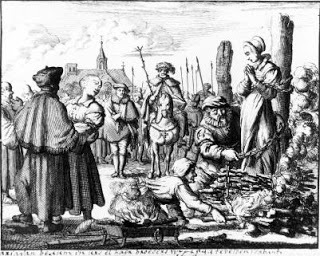
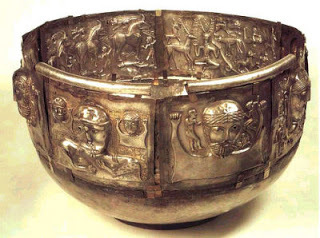 The Gundestrop Cauldron from DenmarkThis cauldron was fashioned out of silver in about 100 BC and
The Gundestrop Cauldron from DenmarkThis cauldron was fashioned out of silver in about 100 BC and found in a peat bog in Gundestrop, Denmark. The decorations depict victims
being plunged headfirst into a sacrificial cauldron.
The cauldron is a symbol of rebirth, the hearth and of abundance and well being. There are many stories from the Ancient Celts that tell of cauldrons from which endless food would pour and nobody would ever go hungry, and the dead if thrown in would return to life albeit without the ability to speak. Some say that they also lacked their soul.In Wicca the cauldron is associated with the goddess, Cerridwen, it not only symbolises the goddess but also the womb. She was an enchantress in Welsh medieval legends and she possessed a cauldron of poetic inspiration in which she made a magical brew of herbs, roots and the foam of the ocean, prepared according to the movements of the heavenly bodies. This potion brewed for a year and a day to yield three drops which bestowed knowledge, inspiration and science.
She is regarded by many modern Pagans as the goddess of rebirth, transformation and inspiration.
She possessed the gifts of prophecy and shape shifting and is associated with water and the Moon which represents the emotions, the unconscious and intuition.
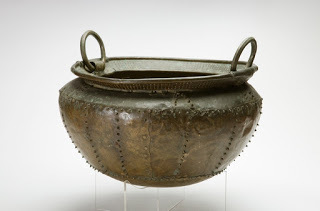 The Lisdrumturk CauldronFound in 1854 Co Monaghan by turf cutters.Dated late Bronze Age
The Lisdrumturk CauldronFound in 1854 Co Monaghan by turf cutters.Dated late Bronze Age
Among the Celts, the priestess of the moon goddess was required to sacrifice human
victims by cutting off their heads over a silver cauldron. The blood was then boiled
to produce a magical drink of inspiration.
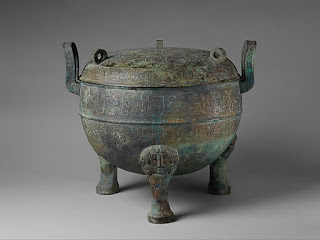 Example of a bronze ritual tripod cauldron with coverfrom the 5th to 4th century BC, China.
Example of a bronze ritual tripod cauldron with coverfrom the 5th to 4th century BC, China.A 14th century Wizard Lord William Soulis was executed using a cauldron. He was described as being a pernicious wizard and perpetrator of the most foul sorceries. According to legend he was capable of summoning demons, the most prominent was Robin Redcap with which he engaged in so many acts of evil depravity that his own castle began to sink into the earth to 'hide its sin from God'
Complaints about Soulis's behaviour reached the King, Robert the Bruce, and
he cried out " Soules! Soules! Go boil him brew!"
Soulis was so unpopular by then that the locals took the King at his word and caught and bound him, using a specially forged chain to bind him as no ordinary rope could contain his evil powers. They took him to the summit of Nine Stang Rig and put him a cauldron of molten lead and suspended it over a large fire.
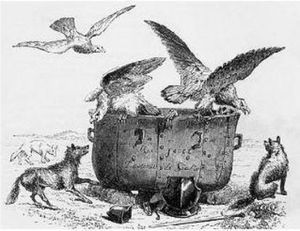
These days cauldrons are not used for such violent acts, I hope,. They represent the female aspect of divinity, the womb and are used in conjunction with wands, swords, athames in symbolic representation of The Great Rite which is the ritualised sexual connection between god and goddess)
Interestingly enough many of the cauldrons used through out southern England from 1650 onwards were made in Somerset. The villages of South Petherton and Montacute were major centres of production. And the Museum of Somerset holds the largest collection of English cauldrons in existence.
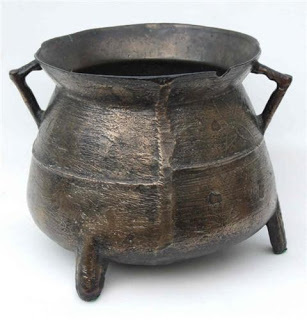
Bronze cauldron from a foundry in South Petherton with the makers name of William Sturton II.
This foundry was producing goods from 1630's to 1690's.
Oh and an interesting snippet to finish with....
Leprechauns hide their gold inside cauldrons, so check yours before use!
Published on February 21, 2018 08:06
February 9, 2018
St Apollonia's Day and a cure for toothache!
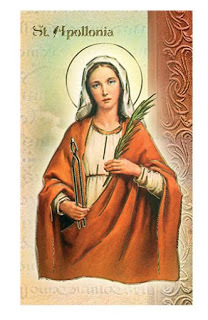
The 9th February is St Appollonia's Day, and is dedicated to the memory of an aged Christian matron of Alexandria. She was one of a group of virgin martyrs who were persecuted during a local uprising against the Christians prior to the persecution by Decius, who was Roman Emperor from 249 to 251.According to legend her torture included having all of her teeth pulled out or shattered.
"Her persecutors seized her and by repeated blows broke all her teeth, then then erected outside the city gates a great pile of faggots and threatened to burn her alive if she refused to renounce her faith. Given at her own request a little freedom she sprang quickly into the fire and was burned to death."Taken fr om an account written in 1260
For this she has become the patron saint of dentists and those suffering with toothache.
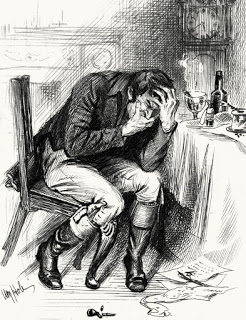
A sure cure for toothache taken from The Homish Apothocary 1561
"The grey worms breeding beneath wood or stones and having many feet, and when they be touched they do cluster together like porkenpicks. These pierced through with a bodkin and put into the tooth that aceth allayeth the pain."
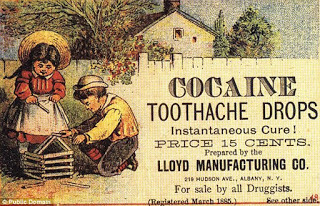
This is an American advert from 1885 offering the Cocaine toothpaste for sale which gives an ‘instantaneous cure’
Cocaine was the first local anesthetic to be used but with its addictive side effects it its use was soon abandoned by health care professionals.
No....really?!
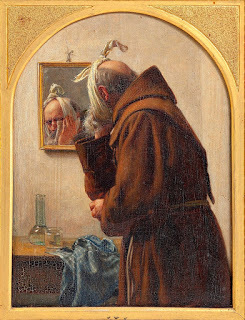
The first written mention of toothache was found on a Sumerian clay tablet which dates from around 5000BC. The tablet is now referred to as ‘The Legend of the Worm’ as in ancient civilisations it was believed that tooth decay and dental pain was caused by tooth worms. This belief persisted until the Age of Enlightenment which was an intellectual movement that dominated the world of ideas in Europe during the 18th century.
A priest -physician Andrew Boorde in the 15th cen-tury recommended a de worming technique for the teeth. ‘ And if the toothache do come by worms make a candle of wax with Henbane seeds and light it and let the perfume of the candle enter the tooth and gape over a dish of cold water and then you may take the worms out of the water and kill them on your nail.’
Leo Kanner in his article The folkore of the Teeth cites the following remedy from Brandenburg
Germany.
‘ One takes a mouthful of salt and goes with it in the evening silently, without greeting or addressing any-one to the churchyard. There make a hole over the last grave, cross two blades of straw over the hole and spit the salt upon it. Then close the hole with mud and the patient goes home as silently as he came. The toothache will disappear and never come back’
Or another recommendation from the same area in Germany is that the toothache can be relieved by kissing a donkey!

Not recommended by modern day Dentists!
Ancient Greeks similarly believed that a mouth wash made from donkey milk would help promote strong teeth and gums.If you don’t fancy kissing a donkey there are few other remedies like spitting into the mouth of a frog in the hope that it will take the pain from you or you could suck on the freshly extracted tooth from a corpse!
Or visit your local Blacksmith as they used to perform dental work as well as tending to your horse...
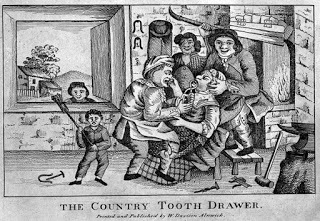
I think that's enough about teeth!
Published on February 09, 2018 04:19
February 6, 2018
Snowdrop
 One of the first flowers of spring, and commonly known as the flower of hope. Although its beauty symbolises purity, it is widely regarded as a omen of death and as suchis considered to be unlucky to take into the house of anybody who is sick, exceptin Shropshire where bunches of the flowers are taken into the house to purify it.
One of the first flowers of spring, and commonly known as the flower of hope. Although its beauty symbolises purity, it is widely regarded as a omen of death and as suchis considered to be unlucky to take into the house of anybody who is sick, exceptin Shropshire where bunches of the flowers are taken into the house to purify it.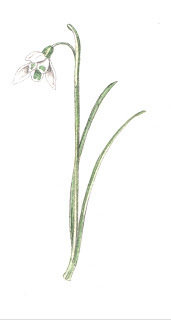 After Adam and Eve were expelled from the Garden of Eden, Eve stood weeping and surveying the snowy wilderness to which they had been sent when an angel appeared. The glowing figure caught a falling snowflake, breathed on it and then handed it to Eve:
After Adam and Eve were expelled from the Garden of Eden, Eve stood weeping and surveying the snowy wilderness to which they had been sent when an angel appeared. The glowing figure caught a falling snowflake, breathed on it and then handed it to Eve:
‘This is an earnest wish, Eve to theeThat sun and summer soon shall be’
The angel vanished and where she had stood the snow had turned into a carpet of snowdrops.
From 'Faerie Flora'
Published on February 06, 2018 05:32
Candlemas: St Mary's Feast of the Candles
The 2nd of February is officially the Feast of Purification and the presentation of Christ in the Temple.Forty day s after Jesus's birth Mary ritually cleansed herself and presented her child in the Temple at Jerusalem. During this visit she met Simeon who prophesied that Jesus would be a light to lighten the Gentiles. So it is tradition on this day that lights and candles are blessed in church and candlelit services and processions are held.
Candlemas Day, plant beans in the day
Put candles and candlesticks away.If Candlemas Day bring snow and rainWinter is gone and won't come againIf Candlemas Day be clear and brightWinter will have another flight
This ancient festival also marks the midway point of winter, halfway between the shortest day and the spring equinox.
Apart from the weather superstitions a few more abound around Candlemas; anybody who hears funeral bells on Candlemas will soon hear of a death of a close friend or relative; each bell that tolls represent a day that will pass before the unfortunate news is heard.Sailors who are always very superstitious are reluctant to set sail on this day as they believe that any voyage begun today will end in disaster.
The Snowdrop in purest white arraieFirst rears her head on Candlemas daiecirca 1500
Candlemas Day, plant beans in the day
Put candles and candlesticks away.If Candlemas Day bring snow and rainWinter is gone and won't come againIf Candlemas Day be clear and brightWinter will have another flight
This ancient festival also marks the midway point of winter, halfway between the shortest day and the spring equinox.
Apart from the weather superstitions a few more abound around Candlemas; anybody who hears funeral bells on Candlemas will soon hear of a death of a close friend or relative; each bell that tolls represent a day that will pass before the unfortunate news is heard.Sailors who are always very superstitious are reluctant to set sail on this day as they believe that any voyage begun today will end in disaster.
The Snowdrop in purest white arraieFirst rears her head on Candlemas daiecirca 1500
Published on February 06, 2018 05:21
December 11, 2017
St Andrew' Day, Old style 11th Dec
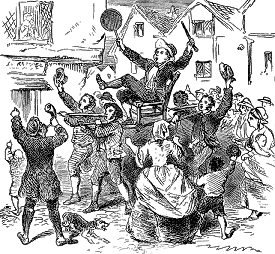
A very interesting custom takes place in Northamptonshire on this date; at midnight a very noisy Tin Can Band makes its way around the villages of this area. It harks back to the old custom of 'Riding the Stang' or the 'Skimmington Ride'.This was always used as a way for the locals to register disapproval of wife beaters. adulterers and other like offenders. Either the guilty person would be caught or a straw dummy used in their place and be paraded through the streets astride a 'stang' or pole. Behind this the Tin Can Band would march, beating pans and kettles, blowing horns and singing insulting songs. Once the offenders home was reached a speech was delivered recounting their crimes and sometimes the straw effigy was burnt for good measure.The ceremony was often repeated three nights in a row, the result being the offender usually left the village.
"There is a man in our town,Who often beats his wife,So if he does it any more,We'll pull his nose right out before,Holler boys, holler boys,Make the bells ring.Holler boys, holler boys,God save the King"
Published on December 11, 2017 06:47
November 26, 2017
Pack Rag Day
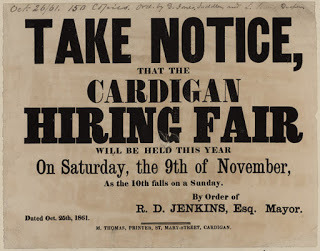
So many interesting days to recount!...This is the day when hiring fairs were held through out the north of the country.It was called pack rag day because the servants who were seeking new places would carry their possessions with them as they visited the fairs in search of employment.
"Servant men, stand up for your wagesWhen the hirings you do goFor you must work all sorts of weatherBoth cold and wet and snow."
Traditional Ballad from Shropshire
Hiring Fairs date from the time of Edward III, and his attempts to regulate the labour market by the Statute of Labourers in 1351 at a time of serious national shortage of workers after the Black death decimated the population.
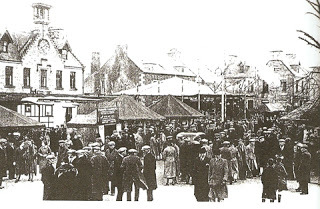
The hopefuls would gather in the street, sporting some sort of badge or tool to signify their speciality. Shepherds held a crook or a tuft of wool, cowmen brought wisps of straw, dairymaids carried a milking stool or pail and housemaids held a broom or mop. This is why sometimes the fairs a re known as mop fairs.If they fitted the employers requirements a shilling would be handed over to seal the bargain for the coming year.
Published on November 26, 2017 04:16
November 24, 2017
Stir up Sunday 21st November
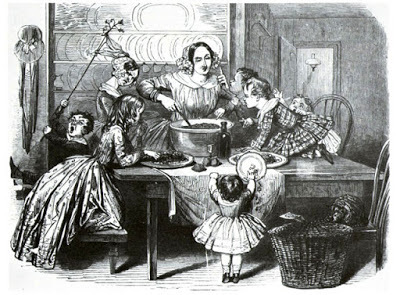
This event is the last Sunday before advent and is traditionally the day on which Noah entered the Ark. The collect from the Church of England begins " Stir, we beseech you, O Lord, the will of the faithful people..."
This was always taken as a reminder to 'stir up' the mixture for the Christmas pudding and pies.
" Stir up we beseech theeThe pudding in the potAnd when we do get homeWe'll eat it piping hot."
Sorry this little gem is a bit late if you are intending to make Christmas pudding, if you do get round to it remember that the mixture must be stirred clockwise with a wooden spoon. All present must take a turn and make a wish.
Published on November 24, 2017 02:50
November 21, 2017
The 20th November is the Feast of St Edmund of East Anglia
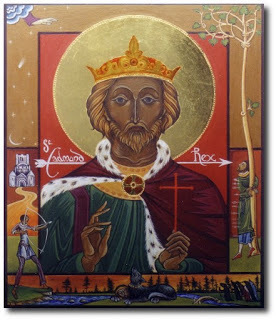
Edmund, King of East Anglia was born of Saxon stock and brought up as a Christian. He became King before 855 until his death in 869. An army of vikings, led by Ingwar, invaded East Anglia and he led his army out to meet them but was defeated and captured. He refused to renounce the Christian faith and was killed, some believe he was shot with arrows then beheaded. His body was buried in a small wooden chapel near where he died. Around 915 his body was discovered to be incorrupt and so was taken to Bedricsworth later called Bury St Edmunds where a community was founded in 925 to take care of the shrine. His body was later relocated to a large new Norman church and re-enshrined in 1198.Folklore relates that his head fell into a thron bush and was hidden and when his followers sought it, the head itself called out to them crying 'here, here.' It was found being guarded between the paws of a giant white wolf.A miraculous freshwater spring broke through the soil where the head had lain. Near the site of a Benedictine Monastery near Hoxne is a deep moat enclosing a small island where the spring is said to be located. The ill and infirm visited the spot during the middle ages believing the waters were healing.
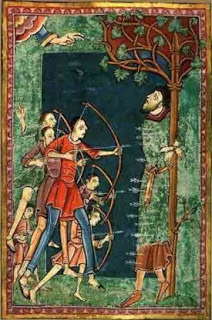
Just south of the village of Hoxne which is believed to be the spot where he was killed is a stone cross that marks the spot of the oak to which Edmund was tied, The memorial reads...'St Edmund the Martyr, Ad 870 Oak tree fell August 1848 by its own weight.'
Near Hoxne lies the Goldbrook Bridge where Edmund is said to have hidden from the Danes. According to legend a pair of newly weds spotted his spurs glistening in the sunlight and as the Danes dragged him away Edmund put a curse on all bridal couples who ever crossed the bridge. Up until the 19th century many wedding parties refused to cross the bridge and took the long way round rather than chance the curse.
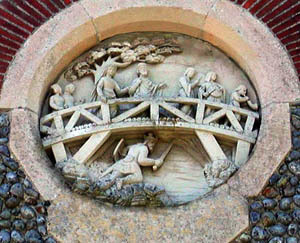
Published on November 21, 2017 05:55
November 10, 2017
Martinmas, Halloween Old Style
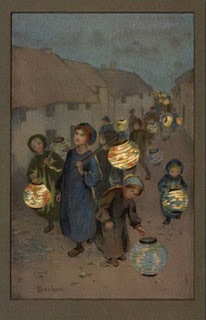
Martinmas is also known as Saint Martin's Day, Feast of Saint Martin, Martinstag as well as Old Halloween. It is the feast day of St Martin of Tours and is the time of year when Autumn seeding was completed and the annual slaughter of fattened cattle was performed. Hiring fairs where farm labourers historically looked for new positions were held at this time of year.Martin of Tours was a soldier in the Roman army, when he decided to convert to Christianity he was later imprisoned for his refusal to fight. Becoming a monk he founded the monastery in Gaul and became the Bishop of Tours. Famous for his generosity towards a drunken beggar to whom he gave his cloak St Martin is now the patron saint of beggars, drunks and the poor. As his feast day falls during the wine harvest in Europe he is also the patron saint of wine growers and innkeepers. (bit of a conflict of interests there I think)
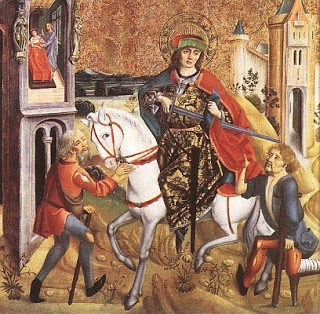
The 11th November is also a second chance to look into the future, so if you wish to do so try this, as performed in Scotland!Take three dishes, fill one with clean water and another with dirty water, the third leave empty. The person wishing to know their future is blindfolded and is directed to choose a dish with their left hand. If they choose the clean dish then their future partner will be a maid or a bachelor, if they choose the dirty water then their partner will be a widow or widower but if they choose the empty one then they will never marry. And if they don't like the results let them try again but remember to move the dishes.
Published on November 10, 2017 02:41
October 20, 2017
Elizabeth I, and her cure for wind!
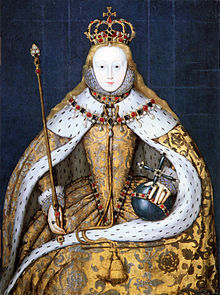
A cure for wind prescribed by the Tudor monarch Elizabeth I
Take ginger, cinnamon, galingale ( a plant in the ginger family) of each one ounce; aniseeds, caraway seeds, fennel seeds, of each half an ounce; mace and nutmegs two dram each; pound together and add one pound of white sugar.Use this powder after or before meat at any time. It comforteth the stomach, helpeth digestion and expels wind greatly.
From the Fairfax Household Book 17th/ 18th century
Published on October 20, 2017 02:45



